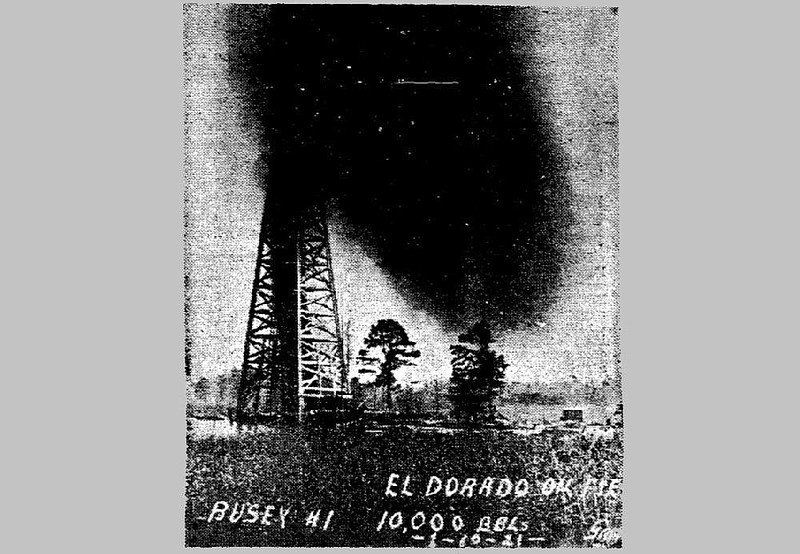In the 1920’s wherever there was oil, life was impetuous and hazardous. America had become oil conscious. Oil drove railroad trains, cars, greased factory wheels, flew airplanes and propelled all matter of machinery.
The first World War created a great, new demand for its by-products. In 1923 the question was ‘what is it that makes a quarter of a million men in dozens of oil fields forsake the comforts of home and drill 17,000 producing wells and nobody knows how many dusters. There was no logic, oil field expenditures were poor investments. Why was $4.50 spent for every $2.00 barrel of oil produced in 1923?
Yet the spirit back of them was magnificent. It was an excellent example of the driving, ebullient force of American private enterprise. All wildcatting was then a considered risk. But the U. S. oil industry has had success in prospecting for new fields.
Certainly the quiet, rural town of El Dorado was an unlikely place for an oil field. Its dirt roads reaching back into small farms and forested hills seldom saw any unusual excitement. In 1906 a gas well blew in and cratered in Caddo Parish, Louisiana. By 1920 Arkansas had producing gas wells and a few small oil wells – but no oil fields. When a producing well was discovered just South of El Dorado, prospectors were certain it was a matter of time until more production would be found in this area. Strangers began appearing in El Dorado wearing heavy corduroys and heavy shoes, where they cruised the ravines and tree-pined hills.
A man named Bruce Hunt gets the chief credit for El Dorado’s oil discovery. In 1919 he borrowed funds from his friend, Sam Arrendale and came to El Dorado and leased 12,500 acres of land for $229.00. He and a respected geologist, J. J. Victor, chose the Constantine Refining Company to test their sites. On April 22, 1920 the drill bit into the Nacatoch sand at more than 2200 feet. A huge volume of gas, estimated at 40 million cubic feet roared from the casinghead. The greatest tragedy occurred when a group of picnickers from Camden came to see the well. Despite warnings one of the group struck a match. The gas-permeated air instantly exploded. The well itself burned and five of the party were lost.
The news of this well brought the oil fraternity from throughout the U.S. to El Dorado. Paul Mattocks and Harley Hinton bought an oil and gas lease from D. E. Armstrong and C. S. Armstrong, his wife, covering 400 acres of land. They also acquired a lease covering 80 acres of land.
Dr. Mitchell who lived in Homer, Louisiana and assigned this lease to the Mitchell Farm Drilling Company. There were three efforts to drill a well and the hole was about 1400 feet into the third well. Mitchell and Bonham had spent $44,000 and were penniless. They offered .51% of the well to Dr. Samuel T. Busey for $10,000.
Dr. Busey was 54 years old. He traveled throughout the Western Hemisphere, practiced medicine in Mexico City until 1910 and brought in an oil well in Bolivia in 1915. He had been in New Jersey when he became interested in the developing of oil fields in Louisiana and Arkansas. He came to El Dorado with his wife and leased the old Arcade Hotel when he could find no suitable place to live.
He did not have the necessary capital to produce the well and Ike Felsenthal, a local merchant, worked to raise the money. Mr. Felsenthal had been interested in the development of oil in El Dorado. Wong Hing a local resident of El Dorado and owner of a Chinese restaurant and laundry had knowledge of events all over the country concerning oil and lent his support to the venture. It should be noted that with the exception of Dr. Busey, all of those responsible for the completion of the Busey well were local residents.
The following are excerpts from eye witness accounts of the day the well came in: Joe K. Mahony was an attorney in El Dorado. “In 1921 Mr. Charlie Murphy and I with some other people went out to the well site. It was only a few minutes before the well came in and when it did, it was only a moment before going over the top of the derrick.” Mr. Murphy threw his hat in the air and gave praise to those who had brought in the well. Excitement ran high and in just a few minutes hundreds had come to the oil well site. For 75 days it blew wide open covering the country side for several miles, changing the color of the sheep on Uncle Miles Murphy’s place a half mile away. The well could be seen easily from the streets of El Dorado by anyone looking because it was only about a mile and a half Southwest of town located on a hill.
At the drilling site the oil men stood apart and talked to themselves, occasionally tasting the oil to check for salt. In a year an Oil field two miles wide and nine miles long was surrounded by dry holes. There were 630 odd wells completed 608 of which were producers. One and a half million barrels of oil were produced in the first year.
The scene later shifted to Norphlet – the Oil Operators Trust Murphy No. 1, came in April 22, 1922. The gas pressure was so great that it blew out a crater 400 feet deep and five acres around. The oil derrick sunk into the mud. At this time the oil boom in El Dorado had considered to be dying down. This spurred it to new heights. About the time activity in the Norphlet field began to slow down, the largest well in the history of the world came in the Smackover field in 1924.
